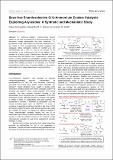Files in this item
Base-free enantioselective C(1)-ammonium enolate catalysis exploiting aryloxides : a synthetic and mechanistic study
Item metadata
| dc.contributor.author | McLaughlin, Calum | |
| dc.contributor.author | Slawin, Alexandra M. Z. | |
| dc.contributor.author | Smith, Andrew D. | |
| dc.date.accessioned | 2020-09-11T23:36:56Z | |
| dc.date.available | 2020-09-11T23:36:56Z | |
| dc.date.issued | 2019-10-14 | |
| dc.identifier | 260858128 | |
| dc.identifier | b0468a74-8857-48c4-86e6-d971fecbb50f | |
| dc.identifier | 85072992478 | |
| dc.identifier | 000485505100001 | |
| dc.identifier.citation | McLaughlin , C , Slawin , A M Z & Smith , A D 2019 , ' Base-free enantioselective C(1)-ammonium enolate catalysis exploiting aryloxides : a synthetic and mechanistic study ' , Angewandte Chemie International Edition , vol. 58 , no. 42 , pp. 15111-15119 . https://doi.org/10.1002/anie.201908627 | en |
| dc.identifier.issn | 1433-7851 | |
| dc.identifier.other | ORCID: /0000-0002-2104-7313/work/61621994 | |
| dc.identifier.other | ORCID: /0000-0002-9527-6418/work/61622013 | |
| dc.identifier.uri | https://hdl.handle.net/10023/20611 | |
| dc.description | We thank the European Research Council under the European Union's Seventh Framework Programme (FP7/2007-2013) ERC grant agreement no. 279850 (A.D.S) and the EPSRC (EP/M508214/1, C.M.) for funding. A.D.S. thanks the Royal Society for a Wolfson Research Merit Award. | en |
| dc.description.abstract | An isothiourea‐catalyzed enantioselective Michael addition of aryl ester pronucleophiles to vinyl bis‐sulfones via C(1)‐ammonium enolate intermediates has been developed. This operationally simple method allows the base‐free functionalization of aryl esters to form α‐functionalized products containing two contiguous tertiary stereogenic centres in excellent yield and stereoselectivity (all ≥ 99:1 er). Key to the success of this methodology is the multifunctional role of the aryloxide, which operates as a leaving group, Brønsted base, Brønsted acid and Lewis base within the catalytic cycle. Comprehensive mechanistic studies, including variable time normalization analysis (VTNA) and isotopologue competition experiments, have been carried out. These studies have identified (i) orders of all reactants; (ii) a turnover‐limiting Michael addition step, (iii) product inhibition, (iv) the catalyst resting state and (v) catalyst deactivation through protonation. | |
| dc.format.extent | 9 | |
| dc.format.extent | 1175858 | |
| dc.language.iso | eng | |
| dc.relation.ispartof | Angewandte Chemie International Edition | en |
| dc.subject | Enantioselective Michael addition | en |
| dc.subject | Inverse secondary kinetic isotope effect | en |
| dc.subject | Isothiourea catalysis | en |
| dc.subject | Mechanistic analysis | en |
| dc.subject | VTNA | en |
| dc.subject | QD Chemistry | en |
| dc.subject | DAS | en |
| dc.subject | BDC | en |
| dc.subject | R2C | en |
| dc.subject.lcc | QD | en |
| dc.title | Base-free enantioselective C(1)-ammonium enolate catalysis exploiting aryloxides : a synthetic and mechanistic study | en |
| dc.type | Journal article | en |
| dc.contributor.sponsor | European Commission | en |
| dc.contributor.sponsor | The Royal Society | en |
| dc.contributor.institution | University of St Andrews. University of St Andrews | en |
| dc.contributor.institution | University of St Andrews. EaSTCHEM | en |
| dc.contributor.institution | University of St Andrews. School of Chemistry | en |
| dc.contributor.institution | University of St Andrews. Biomedical Sciences Research Complex | en |
| dc.identifier.doi | 10.1002/anie.201908627 | |
| dc.description.status | Peer reviewed | en |
| dc.date.embargoedUntil | 2020-09-12 | |
| dc.identifier.grantnumber | N/A | en |
| dc.identifier.grantnumber | WM140071 | en |
This item appears in the following Collection(s)
Items in the St Andrews Research Repository are protected by copyright, with all rights reserved, unless otherwise indicated.

